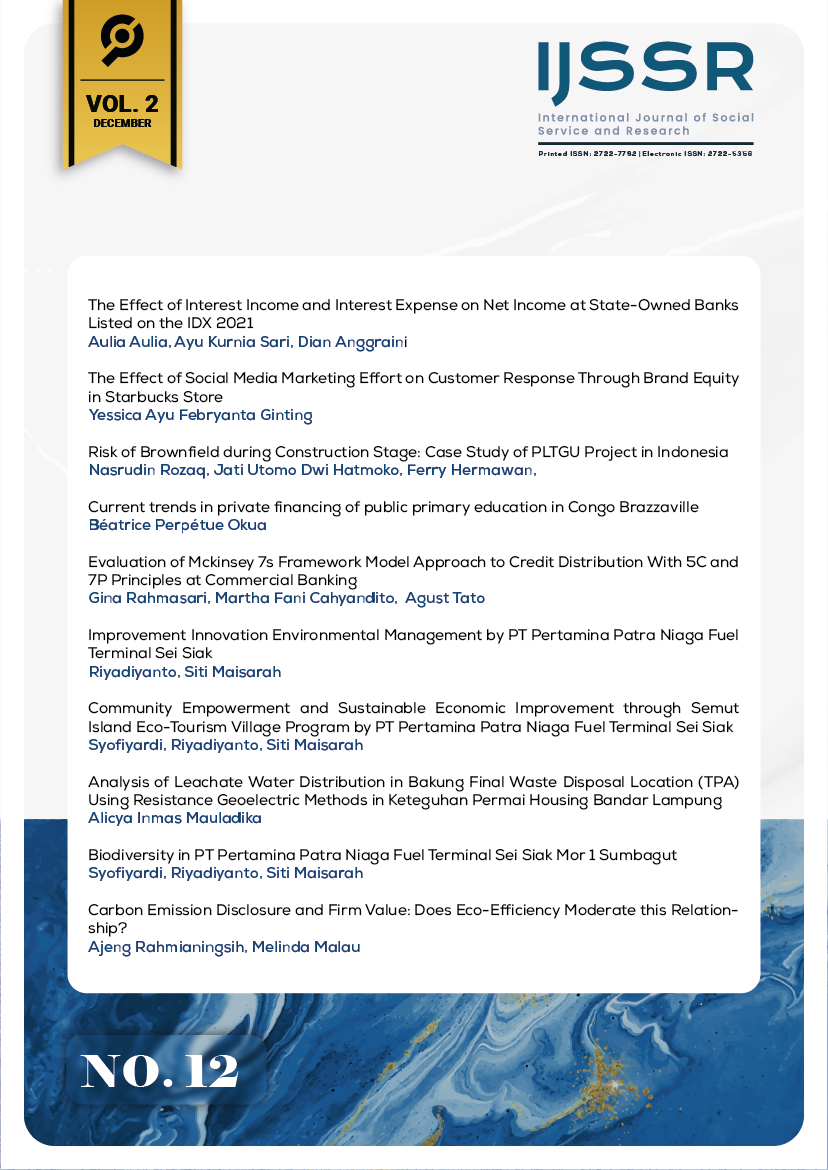Evaluation of Mckinsey 7s Framework Model Approach to Credit Distribution With 5C and 7P Principles at Commercial Banking
DOI:
https://doi.org/10.46799/ijssr.v2i12.209Keywords:
parental support, learning motivation, self-regulated learningAbstract
The strategic management process in lending is carried out starting from environmental analysis when determining market targets and credit risk assessments, then formulating strategies in lending by applying the principle of prudence in each credit process which then implementing the strategy can be seen from the NPL ratio, and the last process is an evaluation of the implementation of the 5C and 7P principles on lending at the Commercial Banking Directorate of PT Bank Mandiri (Persero) Tbk. The study aims to find out the implementation of the 5C and 7P principles. This study uses descriptive methods to identify problems, explain symptoms, and examine conditions and prevailing practices based on the information collected. Moreover, based on the explanation, from each item of the questionnaire, it can be concluded that the application of the 5C and 7P principles to credit distribution at Bank Mandiri is quite good, but it is necessary to pay attention to several subvariables, especially personality on the 7P principle, profitability on the 7P principle, and the Bank's profitability.
References
Buchory, H. A. (2014). Analysis Of The Effect Of Capital, Credit Risk And Profitability To Implementation Banking Intermediation Function (Study On Regional Development Bank All Over Indonesia Year 2012). International Journal of Business, Economics and Law, 4(1), 133–144. Google Scholar
Creswell, J. W., & Poth, C. N. (2016). Qualitative inquiry and research design: Choosing among five approaches. Sage publications. Google Scholar
Hanafizadeh, P., & Ravasan, A. Z. (2011). A McKinsey 7S model-based framework for ERP readiness assessment. International Journal of Enterprise Information Systems (IJEIS), 7(4), 23–63. Google Scholar
IBI. (2015). Bisnis Kredit Perbankan. PT Gramedia Pustaka Utama.
Kasmir. (2014). Manajemen Perbankan. Jakarta: PT Raja Grafindo Persada.
Kola, F., Gjipali, A., & Sula, E. (2019). Commercial bank performance and credit risk in Albania. Journal of Central Banking Theory and Practice, 8(3), 161–177. Google Scholar
Psillaki, M., Tsolas, I. E., & Margaritis, D. (2010). Evaluation of credit risk based on firm performance. European Journal of Operational Research, 201(3), 873–881. Elsevier
Puspitasari, D. (2009). Analisis Pengaruh CAR, NPL, PDN, NIM, BOPO, LDR, dan SUKU BUNGA SBI Terhadap ROA. Universitas Diponegoro. Google Scholar
Putra, W., & Widjaja, H. (2019). Penerapan Prinsip Kehati-Hatian Dalam Penyaluran Kredit (Studi Kasus Di Bank Bri Cabang Semarang). Refleksi Hukum: Jurnal Ilmu Hukum, 3(1), 81–96. https://doi.org/10.24246/jrh.2018.v3.i1.p82-97 Google Scholar
Raharjo, P. G., Hakim, D. B., Manurung, A. H., & Maulana, T. N. A. (2018). Determinant of capital ratio: A panel data analysis on state-owned banks in Indonesia. Bulletin of Monetary Economics and Banking, 16(4), 395–414. Google Scholar
Rahmi, M. A. N. (2022). Utilization the Economic Value of Intellectual Property (Copyright) as Collateral Object in Indonesia. LEGAL BRIEF, 11(5), 2742–2751. Google Scholar
Sabrie, H. Y., Tasya, A. A., Taufik, H. F., Tanusaputri, A. M., & Utomo, Y. A. (2022). Implementation of Syndicated Credit Agreements by Conventional Commercial Banks during the COVID-19 Pandemic. Google Scholar
Sayekti, N. W., & Mauleny, A. T. (2013). Analisis Kinerja Perbankan Syariah Di Indonesia: Pra Dan Pasca Undang-Undang Nomor 21 Tahun 2008 Tentang Perbankan Syariah. Jurnal Ekonomi & Kebijakan Publik, 4(1). Google Scholar
Sekaran, U., & Bougie, R. (2017). Metode Penelitian untuk Bisnis: Pendekatan Pengembangan-Keahlian (6th ed.). Salemba Empat. Google Scholar
Yanti, T. A. (2020). Analisis Pengaruh Risiko Kredit Terhadap Profitabilitas Bank Syariah Sumatera Utara. Ekonomi, Keuangan, Investasi Dan Syariah (EKUITAS), 1(2), 93–99. Google Scholar
Published
Issue
Section
License
Copyright (c) 2022 Gina Rahmasari, Martha Fani Cahyandito, Agust Tato

This work is licensed under a Creative Commons Attribution-ShareAlike 4.0 International License.
Authors who publish with this journal agree to the following terms:
- Authors retain copyright and grant the journal right of first publication with the work simultaneously licensed under a Creative Commons Attribution-ShareAlike 4.0 International. that allows others to share the work with an acknowledgement of the work's authorship and initial publication in this journal.
- Authors are able to enter into separate, additional contractual arrangements for the non-exclusive distribution of the journal's published version of the work (e.g., post it to an institutional repository or publish it in a book), with an acknowledgement of its initial publication in this journal.
- Authors are permitted and encouraged to post their work online (e.g., in institutional repositories or on their website) prior to and during the submission process, as it can lead to productive exchanges, as well as earlier and greater citation of published work.













